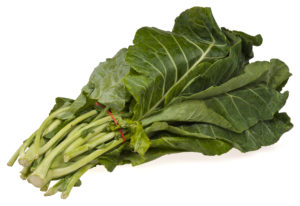Collard Greens: Superfood That’s Sweeter Harvested in Cool Weather
go.ncsu.edu/readext?579051
en Español / em Português
El inglés es el idioma de control de esta página. En la medida en que haya algún conflicto entre la traducción al inglés y la traducción, el inglés prevalece.
Al hacer clic en el enlace de traducción se activa un servicio de traducción gratuito para convertir la página al español. Al igual que con cualquier traducción por Internet, la conversión no es sensible al contexto y puede que no traduzca el texto en su significado original. NC State Extension no garantiza la exactitud del texto traducido. Por favor, tenga en cuenta que algunas aplicaciones y/o servicios pueden no funcionar como se espera cuando se traducen.
Português
Inglês é o idioma de controle desta página. Na medida que haja algum conflito entre o texto original em Inglês e a tradução, o Inglês prevalece.
Ao clicar no link de tradução, um serviço gratuito de tradução será ativado para converter a página para o Português. Como em qualquer tradução pela internet, a conversão não é sensivel ao contexto e pode não ocorrer a tradução para o significado orginal. O serviço de Extensão da Carolina do Norte (NC State Extension) não garante a exatidão do texto traduzido. Por favor, observe que algumas funções ou serviços podem não funcionar como esperado após a tradução.
English
English is the controlling language of this page. To the extent there is any conflict between the English text and the translation, English controls.
Clicking on the translation link activates a free translation service to convert the page to Spanish. As with any Internet translation, the conversion is not context-sensitive and may not translate the text to its original meaning. NC State Extension does not guarantee the accuracy of the translated text. Please note that some applications and/or services may not function as expected when translated.
Collapse ▲Most leafy greens are available year-round, but taste sweeter when harvested in colder weather. During winter months, greens have the capacity to boost the immune system when most vulnerable to illness. Considered a super food, one cup of cooked collards contains 289% of the daily value (DV) for vitamin A and 58% DV for vitamin C, both strengthening immune function. These anti-oxidants also protect cells from damage, reducing your chance of developing cataracts and lowering risk of skin cancer.
One cup also offers 30% DV for fiber, which helps you maintain a healthy digestive tract.
Collards are great for bone health. One cup contains 966% DV for vitamin K and 27% DV for calcium. Vitamin K improves calcium absorption and exhibits anti-cancer effects in research studies.
Collard leaves should look dark green and healthy when purchasing. They keep in a plastic bag in the fridge for around 5 days and sometimes longer, especially if you purchase from a local grower. Rinse under cool water right before cooking.
Cut the stems and any bruised or discolored areas of the leaves off. To cut, stack 6 or so leaves, roll into a cylinder, and slice into ribbons. Then cut across the ribbons for a coarse chop.
Because collard greens and kale can be prepared using the same methods, you may exchange them in recipes.
This recipe, especially served with cornbread, makes a complete meal:
Collards with white beans
Makes 4 – 6 servings
| Ingredients |
|---|
| 2 tablespoons olive oil |
| 1 medium onion, chopped |
| 3 cloves garlic, chopped |
| 1 can chicken or vegetable broth |
| 1 bay leaf |
| 1 can minced tomatoes |
| 1 tablespoon molasses |
| 1 tablespoon brown sugar |
| 1 tablespoon balsamic vinegar |
| 1 tablespoon smoked paprika or liquid smoke flavoring |
| ½ teaspoon dried thyme |
| ½ teaspoon salt |
| 1 pound collard greens, chopped |
| 1 can Great Northern beans |
| 1 cup whole grain couscous |
| 1 cup shredded cheddar cheese (optional) |
Instructions
Thoroughly wash collards, cut off stems and stack in piles of 4 – 6 leaves. Roll into cylinder and slice into ribbons. Cut across ribbons for a coarse chop and set aside. Heat olive oil in large skillet (need lid later) over medium low to medium heat. Chop onion and add to skillet. Sauté for several minutes, stirring frequently, and add chopped garlic. Cook until onion is slightly brown. Add broth through collard greens and turn up the heat until the mixture is nicely simmering. Cover and simmer for 15 minutes, stirring occasionally. Add beans and simmer for 10 more minutes. Stir in couscous and bring to a boil. Then turn the heat off and let sit covered by 5 minutes. Top with cheddar cheese as desired.





